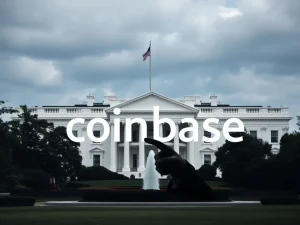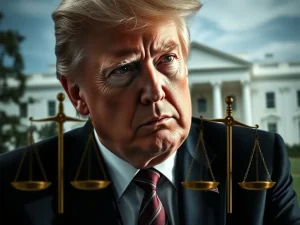Unveiling the Controversial US-Japan Trade Deal: A $550 Billion Investment Under Scrutiny

While the cryptocurrency market often operates on its own unique dynamics, major global economic shifts and significant capital movements can send ripples across all financial sectors. The recently finalized US-Japan Trade Deal, with its colossal $550 billion investment pledge, is one such macro-economic event that warrants attention. How might such a massive redirection of funds influence global liquidity, investment sentiment, and potentially even the broader economic landscape that indirectly impacts digital assets?
What’s the US-Japan Trade Deal All About?
The July 2025 US-Japan Trade Deal has captured headlines, primarily due to an unprecedented $550 billion investment commitment from Japan. This substantial pledge is contingent on Tokyo channeling funds into specific, vital U.S. sectors. These include:
- Energy infrastructure
- Semiconductors
- Critical minerals
- Pharmaceuticals
- Shipbuilding
In return for this investment, the agreement outlines a reduction in U.S. tariffs on Japanese vehicles, decreasing them from 25% to 15%. This reciprocal arrangement aims to foster economic cooperation and strengthen supply chains between the two nations.
The $550 Billion Investment Pledge: A Game Changer?
The centerpiece of this agreement is undoubtedly the $550 Billion Investment Pledge. This massive sum is intended to be channeled through a unique ‘Japanese/USA investment vehicle,’ reportedly utilizing Japanese government funds to support projects that will likely involve private-sector participation. Imagine a scenario where a new chip manufacturing facility in the U.S. needs financing. This investment vehicle could provide the necessary capital, potentially followed by favorable lease terms for the company. Intriguingly, the agreement suggests that 90% of the rental revenue from such arrangements would flow directly to the U.S. government.
Treasury Secretary Scott Bessent highlighted this fund as a crucial element in securing the reduced tariff rate for Japanese vehicles, emphasizing its strategic importance for American industries. However, the sheer scale and proposed structure of this investment have raised questions among financial observers.
Trump’s Influence: A New Era of Economic Control?
A notable aspect of the deal is the significant influence granted to President Trump over the allocation of these funds. The White House has explicitly stated that the investment will be directed ‘at President Trump’s direction.’ This provision has sparked considerable debate, as it concentrates substantial economic decision-making power within the executive branch regarding a foreign nation’s investment. This level of Trump Control over such a large sum of foreign capital is a unique feature in international trade agreements, prompting discussions about its implications for future bilateral deals and the balance of economic power.
Why Analysts Doubt the Economic Viability
Despite the grand pronouncements, analysts and industry experts express considerable skepticism regarding the Economic Viability of this $550 billion pledge. Their doubts stem from several key areas:
- Lack of Enforceable Mechanisms: Critics argue the agreement lacks concrete, legally binding commitments to ensure the investment materializes as planned.
- Unclear Timelines: Specific schedules for when and how these funds will be deployed remain ambiguous, making it difficult to track progress or hold parties accountable.
- Structural Uncertainties: The exact governance structure of the ‘Japanese/USA investment vehicle,’ including conflict-of-interest safeguards, has not been fully clarified.
- Profit-Sharing Discrepancies: While the U.S. outlines a 90% revenue retention, Japanese officials emphasize that profit-sharing should reflect the ‘degree of contribution and risk taken by each party,’ indicating a potential misalignment in expectations.
Takahide Kiuchi, a former Bank of Japan policymaker, described the commitment as a ‘target’ rather than a binding promise, cautioning that U.S. labor costs and potential trade policies under Trump could deter Japanese firms from expanding investments as envisioned.
Is This Investment Pledge Just ‘Vaporware’?
The term ‘vaporware’ has been used by some experts, including Brad Setser, a former U.S. Treasury official, to describe this substantial Investment Pledge. He suggests the $550 billion figure might resemble an overhyped product unlikely to fully materialize beyond existing or already planned projects, such as the Alaska LNG facility. This sentiment underscores the concern that the pledge is more aspirational than actionable.
The deal’s ambiguity is further compounded by ongoing legal challenges to Trump’s tariffs, including a court hearing on the president’s authority under the International Emergency Economic Powers Act to impose wide-ranging duties. Analysts at Piper Sandler noted that such legal uncertainties could deter foreign companies from making large U.S. investments they might not otherwise pursue.
Broader Implications and Future Models
Analysts at Bank of America suggest that this deal could serve as a model for other trade partners, particularly countries like South Korea, which share similar economic profiles with Japan, including high U.S. exports and non-tariff trade barriers. The U.S. administration’s focus on redirecting foreign capital to American industries reflects broader strategic goals aimed at bolstering national competitiveness in key sectors.
However, the lack of enforceable terms and concrete metrics for measuring progress raises significant concerns about the investment’s credibility. Past U.S. trade agreements, including those with South Korea, have seen similar investment pledges fall short due to shifting economic conditions and political priorities. As other nations consider adopting similar models, policymakers will face the challenge of balancing ambitious goals with practical execution. The Japan deal highlights the potential risks of relying on unverified investment commitments to offset trade imbalances, especially in an environment of persistent legal and political uncertainties.
Conclusion
The US-Japan Trade Deal marks a significant moment in bilateral economic relations, promising a colossal $550 Billion Investment aimed at boosting American industries. While the stated goal is to enhance national competitiveness and reduce tariffs, the unprecedented level of Trump Control over these funds and the substantial doubts surrounding the deal’s Economic Viability have cast a shadow over its future. Experts caution that this ambitious Investment Pledge might be more aspirational than actionable, potentially resembling ‘vaporware’ if robust frameworks for accountability and transparency are not established. The success of this agreement, and its potential as a model for future global trade, will ultimately hinge on the development of concrete mechanisms to ensure its promises translate into tangible economic benefits.
Frequently Asked Questions (FAQs)
What is the core agreement of the US-Japan Trade Deal finalized in July 2025?
The core agreement involves Japan pledging an unprecedented $550 billion investment in key U.S. sectors like energy, semiconductors, and pharmaceuticals, in exchange for the U.S. reducing tariffs on Japanese vehicles from 25% to 15%.
Who has control over the allocation of the $550 billion investment?
The White House has stated that the investment will be directed ‘at President Trump’s direction,’ granting him significant influence over the allocation of these funds.
Why are analysts skeptical about the viability of this investment pledge?
Analysts are skeptical due to a lack of enforceable mechanisms, unclear timelines, structural uncertainties in the investment vehicle, and discrepancies in profit-sharing expectations between the U.S. and Japan. Concerns also exist about U.S. labor costs and potential trade policies deterring Japanese firms.
What sectors are targeted for the $550 billion investment?
The investment is targeted at critical U.S. sectors including energy infrastructure, semiconductors, critical minerals, pharmaceuticals, and shipbuilding.
Could this US-Japan trade deal serve as a model for other countries?
Analysts suggest the deal could serve as a model for other trade partners, particularly countries like South Korea, which share similar economic profiles with Japan. However, the challenges in implementing this specific pledge raise questions about its replicability.
What are the potential legal challenges affecting the deal?
Legal challenges to Trump’s tariffs, including a court hearing on the president’s authority under the International Emergency Economic Powers Act, could complicate the deal’s implementation and deter foreign companies from making large U.S. investments.








